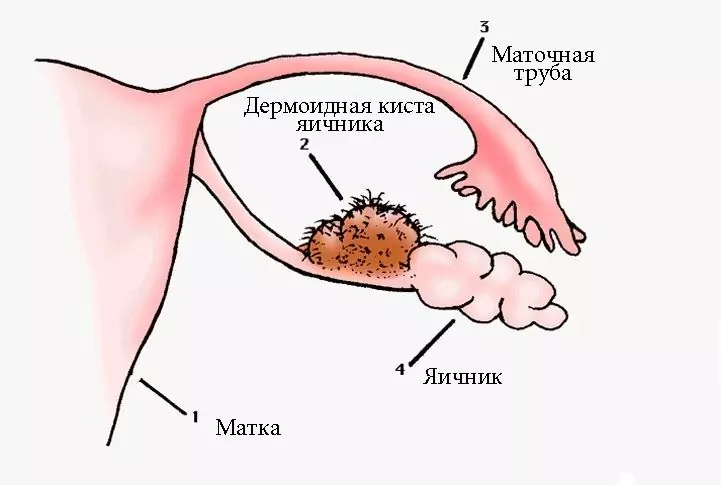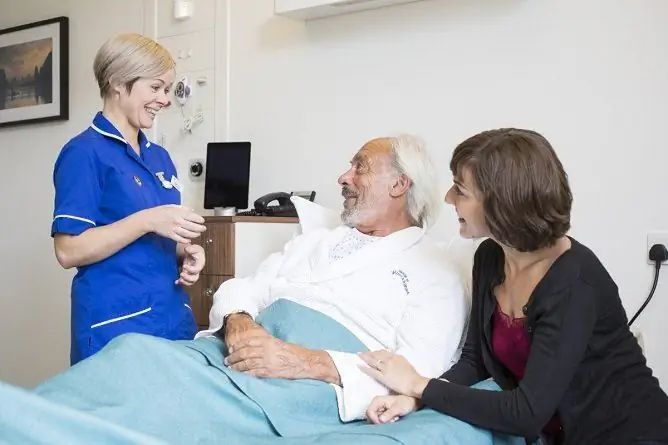- Author Rachel Wainwright [email protected].
- Public 2023-12-15 07:39.
- Last modified 2025-11-02 20:14.
Segmental pneumonia: right-sided and left-sided, causes, treatment, complications
The content of the article:
- Features of the anatomical structure of the lungs
- Classification of pathology
-
The reasons for the development of pneumonia
Trigger factors
- Symptoms
-
Diagnostics
Differential diagnosis
-
How to treat segmental pneumonia
- Antibiotic therapy
- Complementary drug treatments
- Non-drug therapy
- Complications
- Video
Segmental pneumonia is a disease in which an inflammatory process affects one or more segments of the lungs. The disease often occurs in children between the ages of 3 and 7, but sometimes develops in adults and older children.

The disease is common in children
Right-sided segmental pneumonia is a fairly common disease. It requires correct diagnosis and adequate therapy, as it has a potential lethality. Left-sided segmental pneumonia, due to the structure of the lungs, is less common.
Of all acute pneumonia, the segmental form accounts for 25% (more often only focal pneumonia is diagnosed). In 95% of cases, the disease is unilateral, only 5% of the lungs are affected on both sides.
Features of the anatomical structure of the lungs
Bronchopulmonary segments are areas of lung tissue that are part of the lobe. They are supplied with blood by the segmental branches of the pulmonary arteries, and ventilation occurs due to their own segmental bronchi. Each lung is made up of segments.

Lungs make up segments combined into lobes
Segments of the upper lobe of the lungs:
| Right lung | Left lung |
| Front | Rear |
| Rear | Front |
| Apical | Upper reed |
| - | Lower reed |
| - | Apical |
The middle lobe of the right lung consists of a lateral and medial segment.
The lower lobe of both lungs is divided into the following segments:
- anterior basal;
- medial basal;
- lateral basal;
- posterior basal;
- upper.
Classification of pathology
Segmental pneumonia can be:
- primary: occurs as an independent disease;
- secondary: is a complication of another illness, such as the flu.
According to the prevalence of the pathological process, pneumonia, as a nosological unit, is classified as follows:
| The form | Features: |
| Segmental | The inflammatory process affects one of the segments of the lungs, while not covering the whole lobe |
| Polysegmental | The functional feature of this form of the disease is the defeat of several segments at the same time. |
The reasons for the development of pneumonia
Segmental pneumonia develops as a result of infection. Most often, it penetrates by airborne droplets, when a person inhales air with particles of sputum, in which pathogenic microbes are localized.

Most often, the infection is transmitted by airborne droplets
Also, pathogenic microorganisms can penetrate by aspiration, descend from the nasopharynx. In rare cases, the causative agents of the disease enter the area of inflammation from the foci of chronic infection (carried along with the blood). Microorganisms that cause atypical forms of pathology can enter the body during oral-genital contacts.
The most common causative agents of primary segmental pneumonia are:
- bacteria: pneumococcus, streptococcus, staphylococcus, Haemophilus influenzae. Mixed infections are often observed, in which several types of bacteria are combined at once;
- viruses: influenza, parainfluenza, adenovirus, respiratory syncytial virus.
The atypical causative agents of the disease include mycoplasma, legionella, chlamydia.
Trigger factors
Factors that increase the likelihood of developing the disease include:
- exudative-catarrhal diathesis in children;
- smoking;
- frequent hypothermia;
- Chronical bronchitis;
- decreased general or local immunity.
Symptoms
In both an adult and a child, the disease begins with an increase in body temperature, the value of this indicator can cross the mark of 39-40 ° C. The patient has symptoms of intoxication in the form of weakness, body aches, headaches, fatigue, drowsiness, sweating. Children may have confusion and seizures.

The disease usually begins with a sharp rise in body temperature
On the second or third day after the onset of the disease, the patient has an abrupt, rare cough. It is accompanied by painful sensations in the epigastric region and in the chest. The patient develops chest pain that worsens with inhalation or exhalation.
With the polysegmental form of the disease, the symptoms are more pronounced. There is tachycardia and shortness of breath in the absence of physical activity. Also, with this form of pneumonia, respiratory failure develops rapidly. Suffocation occurs when the patient cannot breathe in or out normally.
Diagnostics
In about every fourth patient in the first days of the disease, the symptoms are not so pronounced, therefore, it is rather difficult to identify segmental lung damage. In other cases, the doctor may suspect the disease if he detects bronchial breathing, a shortened percussion sound, or moist fine bubbling rales.

If pneumonia is suspected, the doctor performs auscultation of the lungs
An x-ray helps to determine the diagnosis; homogeneous intense shadows are visible on it, resembling a triangle in shape and having clearly defined boundaries. In the analysis of blood, an increase in the number of leukocytes and an increased ESR are observed.
Differential diagnosis
Segmental pneumonia is differentiated with the following pathologies:
- pulmonary tuberculosis;
- lung infarction;
- primary and metastatic cancer;
- foreign body in the bronchi;
- other forms of pneumonia (interstitial, focal).
How to treat segmental pneumonia
The main goals of pneumonia treatment are:
- destruction of the pathogen that caused the development of the disease;
- reduction of intoxication;
- resorption of foci of inflammation in the lungs.
In most cases, therapy for segmental lung damage is carried out at home. Hospitalization is subject to patients in whom previous treatment was ineffective, as well as patients with a high risk of complications (especially children and the elderly).
Antibiotic therapy
Immediately after the diagnosis is established, the patient is prescribed broad-spectrum antibiotics: penicillins, fluoroquinolones, cephalosporins. They help eliminate infection in the body.

For uncomplicated disease, oral antibiotics are used
In milder forms of the disease, drugs are prescribed in the form of tablets or suspension for oral administration. In other cases, drugs are used in the form of intramuscular or intravenous injections.
Complementary drug treatments
In order to eliminate airway obstruction, mucolytic and expectorant drugs are prescribed. They contribute to the liquefaction and elimination of phlegm from the bronchial tract, without increasing its amount. This allows you to get rid of symptoms such as coughing and helps to cope with the inflammatory process.
In severe forms of the disease, hormonal drugs are prescribed: Prednisolone, Dexamethasone, Mometasone. To stop intoxication, infusion of saline solutions, detoxification agents, glucose can be carried out. Resorption of infiltrative changes is facilitated by the introduction of calcium chloride.
Non-drug therapy
Treatment of segmental pneumonia is complemented by physiotherapeutic methods (UHF, drug electrophoresis, UFO). In order to improve the drainage of the bronchi, massage and breathing exercises are used.

Massage helps restore lung function
During the period of treatment, the patient must comply with bed rest, eat right and lead a healthy lifestyle.
In mild to moderate forms of the disease, with proper treatment, recovery usually occurs within three weeks.
Complications
If the treatment of the disease is not started on time, the patient may experience the following complications:
- pleurisy (serous and fibrinous);
- lung abscess;
- obstructive syndrome;
- empyema of the pleura.
The accumulation in tissues and blood of toxins produced by bacteria or viruses that caused inflammation can lead to the development of complications that affect the nervous or cardiovascular system: neurotoxicosis, acute heart failure, collapse.
Segmental pneumonia is an insidious disease. Since in some cases its clinical picture is blurred, careful diagnosis and competent treatment are required. Therefore, if you suspect the development of pathology, it is necessary to seek advice from a pulmonologist, therapist or pediatrician as soon as possible.
Video
We offer for viewing a video on the topic of the article.

Anna Kozlova Medical journalist About the author
Education: Rostov State Medical University, specialty "General Medicine".
Found a mistake in the text? Select it and press Ctrl + Enter.






